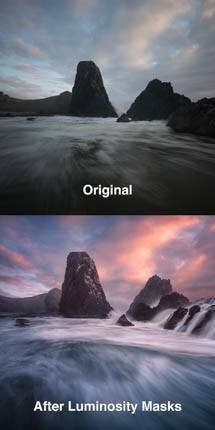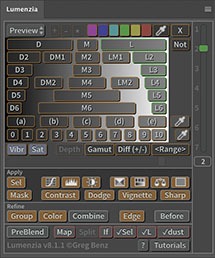When your subject has similar luminosity and color to its surroundings, simple luminosity masks often struggle to get the job done. Neil Williams ran into this scenario when he shot the image below. He emailed me asking how he could use Lumenzia to help brighten this white temple against this relatively bright sky. This is a great example of a common problem, and he offered to let me use him image for this tutorial.
Luminosity masks are well suited to a challenge like this because the building is slightly darker than the sky, and alternatives like manual brushing or the pen tool would be a nightmare with all of the fine detail along the temple and trees. However, no single luminosity mask will adequately separate the temple from both the sky and trees. So we need to use a more advanced combination of custom luminosity masks and some hand painted layer masks to get the job done.
Here’s a summary of the workflow used to edit the image:
- Remove dust spots and distractions. This should ideally be done first, to avoid including dust spots in the luminosity masks
- Click “✓dust” in Lumenzia to visualize the dust, as well as create a blank layer for cloning and activate the spot healing brush.
- Paint with the spot healing brush to remove the dust spots.
- Click “✓dust” again to cycle through the various visualizations to check for anything that was missed.
- Click “X” to clear the dust visualization.
- Use the spot healing brush to remove the lamp.
- Lighten the building. The masks involved here are the trickiest part of the edit.
- Create a new levels adjustment layer. Because the brighter sky makes the histogram useless for determining how much you can safely bring in the white point to edit the building, a good way to safely brighten the building is to hold <alt/option> while bringing in the white point and watch to see when the temple starts to clip and then back off a little. Note that waiting to adjust levels until after you add the layer/luminosity masks won’t improve the histogram, as it is based on the layers below and ignores the masking on the levels layer (you could mask the underlying image, but then the transparent pixels show as lots of white in the histogram).
- Temporarily hide the adjustment layer (so that it does not affect the luminosity mask in the next step).
- Add a midtones mask by clicking “(c)” and then “Mask”. This mask helps achieve a few goals. It avoids lightening the shadows of the temple, which creates better contrast when lightening. It also minimizes any targeting of the dark trees or bright sky (it does not eliminate them on its own, but is a simple way to help reduce targeting of the sky).
- Make the adjustment layer visible again to be able to see its impact.
- Add a group with a black layer mask. This allows us to selectively paint white to reveal the adjustment where needed. A simple soft, white brush is all that is needed here. The adjustment will spill into the sky and cause unwanted lightening, but we’ll fix that in the next steps.
- Add another group, but with a white layer mask this time. We will use this to paint out the sky, which should not be lightened. This is the most important mask for separating the building from the sky.
- Temporarily hide the adjustment again while creating any luminosity selections (as the building is better separated before lightening it). Create sky selections as needed (you’ll frequently need more than one to paint out all critical sky areas).
- I clicked (e), adjusted to 9.99 gamma, and clicked “Sel” to make the first sky selection. The gamma adjustment helps create a stronger selection, without clipping at the sky edges. Paint with a soft, black brush on the white group mask to stop brightening the sky. You should have the levels layer visible while brushing to see what effect the mask is having.
- I then clicked L3, adjusted white levels, and clicked “Sel” to make a secondary sky selection to be able to paint black on a few pixels that weren’t included in the first sky selection. I choose to use the whites slider in the levels adjustment here because the mask was starting from a darker point and didn’t have as much risk of clipping.
- It is frequently helpful to use “Sel” to save your luminosity selections when working advanced/custom selections, so that you can reload and reuse them later if you find any areas that need adjustment in the mask.
- Enhance sky color.
- Create a new HSL adjustment layer
- Set the targeting to red, set saturation to +51, and drag out the blue slider to include the entire sky with a natural look.
- Keep the building relatively neutral. The sky enhancement has also affected the building. Rather than going through the trouble of creating a new sky selection, we can simply adjust the saturation of the building through the masks we have already created.
- Create a new HSL adjustment layer right above the levels adjustment. This is inside the two groups and therefore has nearly the same masking as the levels layer. In this case, the midtone Z(c) mask isn’t needed for color adjustment, but you could also create another group to put both adjustment in and this would give you the exact same mask for HSL that we already created for Levels.
- Set saturation to -45.
- Crop the image as needed. I like to do this late in the process to keep options open to change the crop later if needed, such as to optimize for a specific print size.
- Add a vignette by using the lasso selection tool and clicking “Vignette”. I should have ideally done this before cropping.
Here are some additional optional steps you might need to use in your own images if you run halos or some dark spots that should have been lightened:
- If you find halos (bright pixels at the edge), you can quickly repair those with the “Edge” tool in Lumenzia v8+. This is particularly helpful for eliminating small issues which may become visible in large prints. The key to fixing them is to expand the area blacked out of the sky. The steps include**:
- <cmd/ctrl>-click the top group mask layer mask (“”Group 2”, the one blacking out the sky). This loads it as a selection.
- Click “Edge” in Lumenzia and choose to isolate edges with a radius of 1 and -1 to contract by 1 pixel. This selects the halo area by pulling in from the existing edges.
- Click on the “Group 2” layer mask to target it and paint with black through the halo selection you just created. This paints out the edge pixels to remove the halo.
- If you find dark spots in the building, this indicates that the top group mask (“Group 2”) blacked out some areas that were not sky. Just paint white free-hand on the that “group 2” mask to fill in any gaps. No luminosity selections are needed to safely paint this isolated interior problems in the mask.
I’ll try to add a demo of this use of the “Edge” button in the future. If you are in my Dodging & Burning Master Course, you can see such an example in section 9.3 video 9h where I use “Edge” to remove some halos created while dodging.

